Understanding Door Construction and Styles - JB Kind Doors
When reading through door catalogues or looking at information in showrooms, we understand that some of the more technical terms, such as 'semi-solid core' and 'beading,' can be overwhelming. So, because we want our clients to be as informed as possible before purchasing one of our doors, here's a convenient and thorough reference to all the door-related phrases you're likely to encounter. After all, knowledge is power!
Core construction
The phrase 'core construction' of a door refers to how it is constructed on the inside. In other words, what would you discover if you chopped a door in half? This substance is known as the 'core structure.' It is typically composed of one of the following materials:
Standard core
A door with a 'standard core'; will be lower in weight than others that are more substantial within. This is because the core structure is half hollow and part cellular, as shown in the illustration.
Semi-solid core:
As the name implies, this type of door has an interior structure that is half solid and partially cellular.
What does a solid core door mean?
Because of its solid core; this sort of door is the heaviest. A solid core door's components are often composed of wood.

Glazed Door construction
Glazed doors are a popular element in many modern interiors. They're fantastic for letting light flow into a room and may also provide some lovely design appeal with exquisite panelling. When it comes to glazed doors, you have a lot of options these days, so it's important to understand what the various phrases represent.
Aperture
This word simply means "opening," and it refers to the open portion of the door where the glass is installed.
Beading
If you look closely at a glazed door, you'll see that there are typically distinctive mouldings around the pane of glass as an added feature. These can be elevated or flushed, which means they are flush with the door.
Safety glass
It is critical that the glass in a glazed door does not cause damage if it is broken in an accident. Therefore, doors are equipped with safety glass, which breaks in such a way that sharp shards do not shatter across a room. Safety glass has been carefully handled in one of two ways: it has been tempered or laminated.
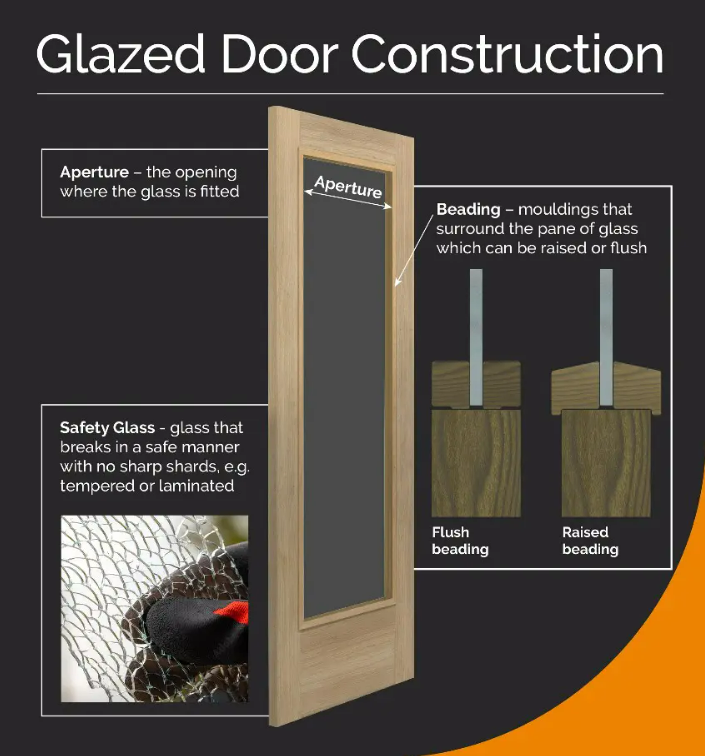
Fire Doors
In case the worst happens, and a fire starts, fire doors must be installed in certain regions of a house. A fire door is made to withstand flames and smoke for a specific amount of time, enabling occupants of a property to flee to safety if necessary.
This fire door, designated FD30/EI30, has been put through testing that show it can withstand fire for more than 30 minutes.
A fire door that has third-party certification demonstrating it will function as promised in the case of a fire is said to be CERTIFIRE approved. Additionally demonstrating a door's quality and traceability is CERTIFIRE accreditation.
A fire door or its frame may be equipped with intumescent strips or seals. These strips will inflate when exposed to heat, ensuring that any holes surrounding the door are sealed. This is a crucial need, and the fire assessment report contains information on how to install a fire door.
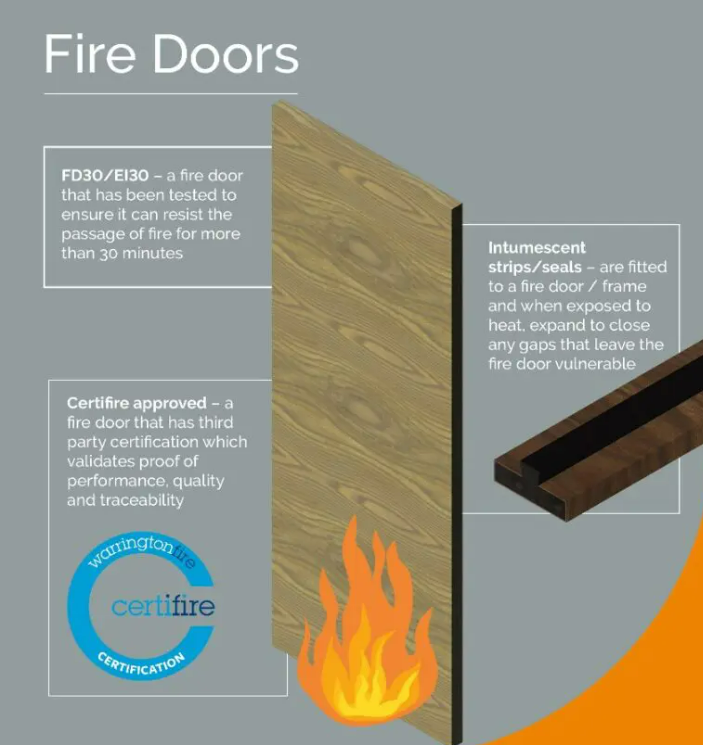
Door Construction
Here are a few helpful terminologies that can help you understand how doors are truly built.
Stile and rail design
This design resembles a piece of woven fabric in several ways. It has a frame and panel construction comprised of horizontal rails and vertical stiles.
Lipping
On occasion, the edge of a door is made up of an additional piece of wood. It can be significantly shortened if necessary to fit door openings.
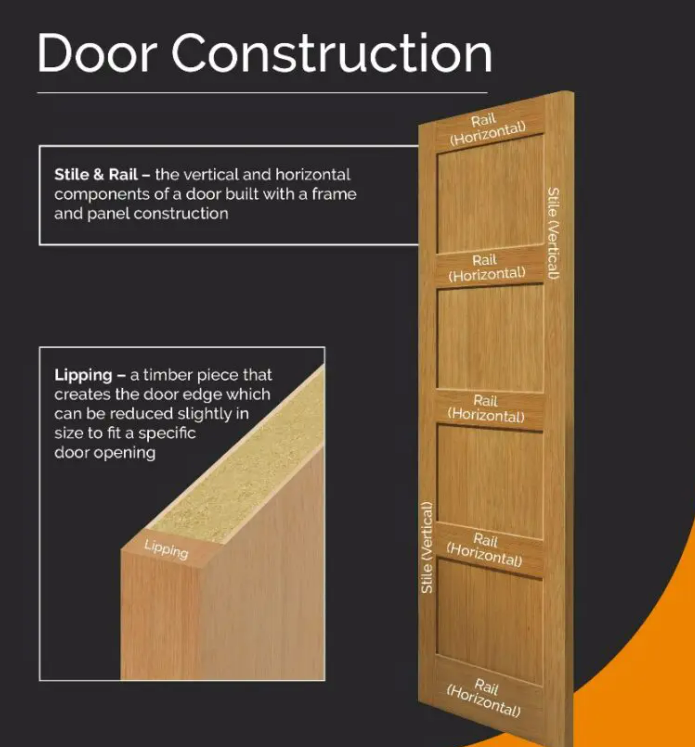
Glazing Types
For areas of the house where you want to let light in, glazed doors are a terrific alternative, as they have a lovely aesthetic appeal on their own. In other situations, such as in a bathroom, you might want the advantages of a glass door but still need some privacy. The primary types to be aware of are listed below:
Glass that is "clear" has a full, transparent opacity, meaning you can see right through it.
Etched glazing design
An etched; design is one that is imprinted on the glass' surface. This is accomplished using acid, giving the result a frosted appearance.
Sand is blasted onto glass to produce "sandblasted" glass, which also has a frosted look.
Obscure Glass
This style of glass is typically created using a mould that has several levels of obscurity.
Bevelled
A "bevelled"; edge is one that is chamfered, or slopes downward.
Diamond Cut
This refers to the process of using a diamond-cutting disc to create lovely grooves in the glass.
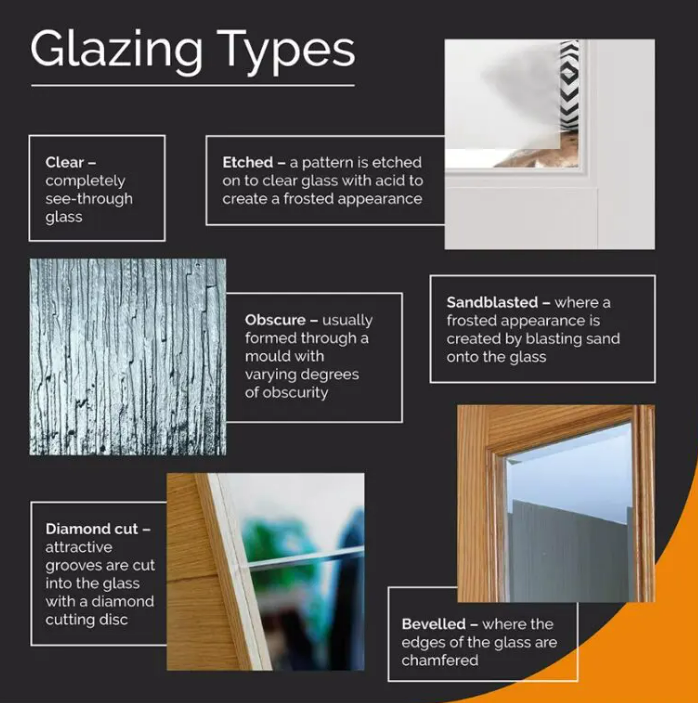
Door Pairs
In many different interior contexts, pairs of doors are a fantastic option. Large reception rooms that may be divided in half by a lovely pair of doors to create a flexible living and entertaining space benefit from their use.
In your search for the ideal door pair designs for your house, you may run into the following terms:
When doors are installed side by side with their vertical edges, or "stiles," meeting squarely in the centre, this is referred to as "square meeting stiles."
Rebated meeting stiles are created when a portion of each door's vertical edge is eliminated, enabling the doors to fit tightly together.
A pair maker fills the gap left by square meeting stiles on one door by attaching a timber moulding to the edge of the door.
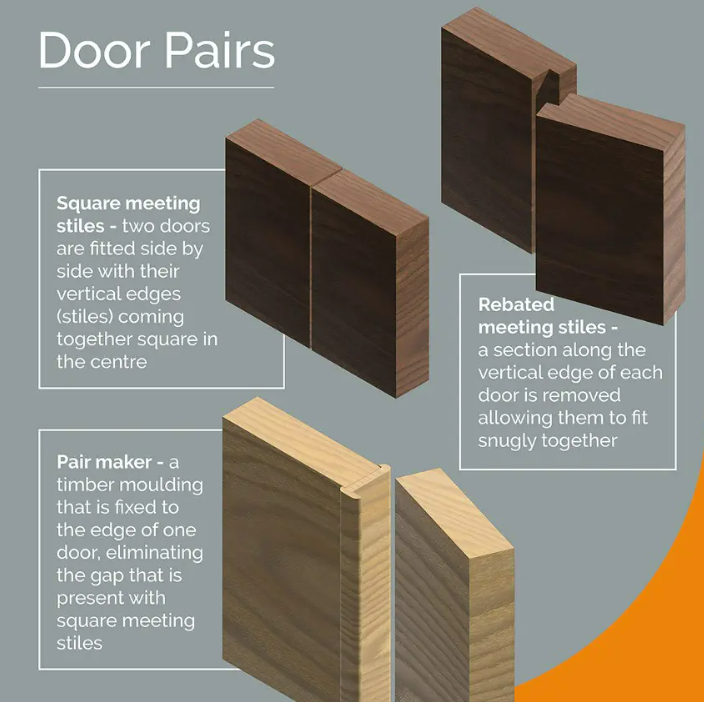
Door Finishes
Doors come in a variety of finishes, some of which let you customise the final appearance, so if that's the route you want to take, it's well worth understanding what terms you're searching for.
Unfinished
If you purchase a door that is prepared and ready for a top-coat finish of either varnish or stain, it is referred to as being unfinished.
Primed
Prepped with a white primer undercoat, these doors are primed and readied for a top-coat paint finish.
Pre Finished
Your pre-finished door is ready to install after having been painted or varnished
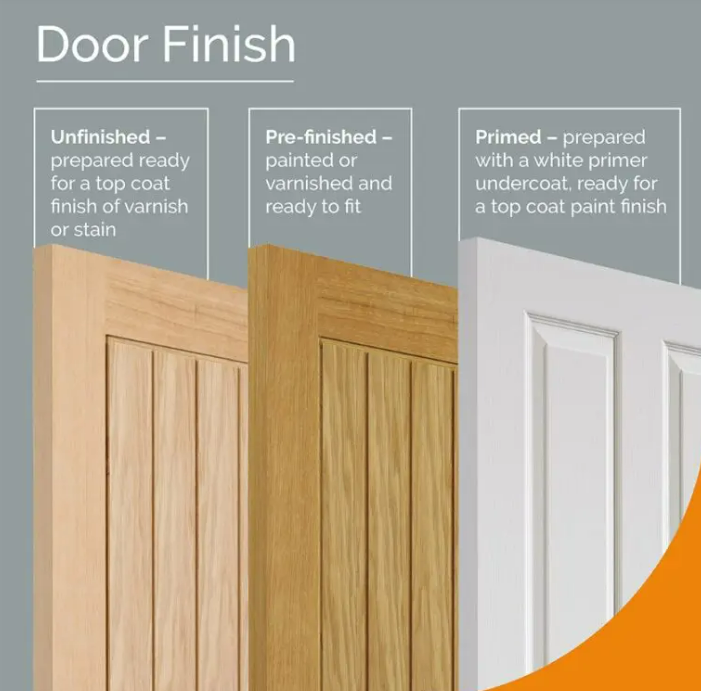
Door Frames
It's simple to overlook the fact that a door also includes the frame on which it rests. Internal door frames typically consist of the following sections and are composed of either wood or MDF:
Head
The top-most horizontal portion of the frame. The vertical sides of the frame are known as jambs
Stops
The strip of wood on the jambs and head that the door rests against when it is closed.
The ornate moulding that spans the space between the border of the frame liners and the wall is known as an
architrave.

Timber Veneer Doors
This style of door is chosen by many consumers. The following two terms should be remembered:
A thin piece of wood (such as oak or walnut) called a veneer is used as a decorative material on the face of doors.
The veneer's visible natural fibre pattern is known as the graining. From door to door, it differs.

Door Styles
Finally, in order to get the desired look, it's quite helpful to know a few descriptive terms for various door styles.
These flat door designs are called:
Flush
Flushed doors can either be completely plain or can have inlays or grooves added to them.
Panelled doors
Panelled doors come in a wide variety of designs. They can be raised traditionally or simply formed. The more modern industrial type of panel is also available but recessed shaker style panels are always popular.
Cottage
The doorways of cottages have a boarded appearance. They are in demand for both classic and modern environments.

We hope you found our guide to some of the more common door terminology useful. We understand how difficult it can be to understand the terminology associated with doors, so we hope this has helped! If you have any further questions or would like to discuss your door options with our friendly, helpful team, please call us at 01472 907051.
Recent Posts
-
Garden Gate Buying Guide
Is your next project adding a garden gate to enhance, protect and secure your garden? Before you do
-
How to cut plasterboard
Whether you're a seasoned tradesperson or trying your hand at DIY, knowing how to cut plasterboard c

